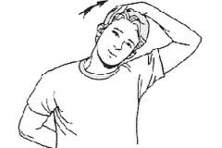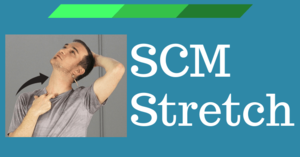Changes Associated with Chronic Cervical Pain
Original Editor - Mostafa Shahien
Top Contributors - Mostafa Shahien, Aminat Abolade, Alicia Fernandes, Oyemi Sillo and Kim Jackson
Introduction[edit | edit source]
Cervical pain is one of the most common complaints by patients presenting to physiotherapy clinics. It disturbs the overall function and quality of life for most patients. It may occur because many different reasons and with many different forms so a good understanding of the possible presentation, changes that occur with chronic pain, and the best treatment modalities is essential.
Changes That Occur With Chronic Cervical Pain.[edit | edit source]
- Pain Centralization - Reduced pain threshold is one of the findings that researchers have found in patients with chronic neck pain[1]. The decrease in pain threshold is recorded both locally and distally in upper and lower limbs, suggesting that central changes occur with chronic cervical pain.
- Proprioceptive changes - Patients with chronic cervical disorders show deficit in the proprioceptive input, which affects postural stability[2]
- Neuromuscular dysfunction - Research has shown that patients with chronic cervical pain exhibit up to 90% deficit in cervical spine muscle strength[3].
- Deep neck flexors have reduced EMG activity and delayed activation when performing arm movements, so the feedforward mechanism is disturbed[4]
- Neck flexor muscles (SCM and anterior scalene) have shown side-specific weakness in unilateral cervical pain.[5]
Assessment[edit | edit source]
Assessment of chronic cervical pain should focus on different areas:
- Postural assessment - observed from three different positions:
- Posterior: shoulder appears elevated (due to tightness of the upper trapezius and levator scapulae muscles).
- Lateral: appearance of a forward head posture.
- Anterior: cord like appearance at SCM.
- Balance assessment - patients with chronic neck pain typically present with impaired postural stability.
- Gait assessment - in extreme cases of cervical dysfunction, the gait pattern may be changed.
- Flexibility and muscle strength assessment
Physical therapy treatment[edit | edit source]
The main aims of physical therapy treatment are to restore the balance between the muscles by stretching the tight muscles and strengthening the weak ones, as well as to improve proprioception. Some physical therapy treatments are:
- Stretching for tight muscles
The most common tight muscles:
Sternocleidomastoid muscle (SCM)
Stretching alone is not sufficient to treat patients with chronic cervical pain, you should also work on deep neck flexor stabilization protocol as it is very important step in the rehabilitation program.
- Proprioceptive exercises.
As stated above, patients with chronic neck pain show deficit in proprioception which affects postural stability. Exercises that involve head and eye movements are thought to improve proprioception, as the vestibular, visual and proprioceptive systems are linked together[8] [9].
You may also look at Sensorimotor Impairment in Neck Pain to see the proprioceptive exercises.
References[edit | edit source]
- ↑ Sterling M, Treleaven J, Edwards S, Jull G. Pressure pain thresholds in chronic whiplash associated disorder: further evidence of altered central pain processing. Journal of Musculoskeletal Pain. 2002 Jan 1;10(3):69-81.https://www.tandfonline.com/doi/abs/10.1300/J094v10n03_05
- ↑ Malmström EM, Fransson PA, Bruinen TJ, Facic S, Tjernström F. Disturbed cervical proprioception affects perception of spatial orientation while in motion. Experimental brain research. 2017 Sep 1;235(9):2755-66.https://www.ncbi.nlm.nih.gov/pubmed/28623390
- ↑ Prushansky T, Gepstein R, Gordon C, Dvir Z. Cervical muscles weakness in chronic whiplash patients. Clinical Biomechanics. 2005 Oct 1;20(8):794-8.https://www.ncbi.nlm.nih.gov/pubmed/15996800
- ↑ Falla D, Jull G, Hodges PW. Feedforward activity of the cervical flexor muscles during voluntary arm movements is delayed in chronic neck pain. Experimental brain research. 2004https://www.ncbi.nlm.nih.gov/pubmed/14762639 Jul 1;157(1):43-8.
- ↑ Falla D, Jull G, Rainoldi A, Merletti R. Neck flexor muscle fatigue is side specific in patients with unilateral neck pain. European Journal of Pain. 2004 Feb;8(1):71-7.https://onlinelibrary.wiley.com/doi/full/10.1016/S1090-3801%2803%2900075-2
- ↑ https://backintelligence.com/sternocleidomastoid-stretch/
- ↑ https://backintelligence.com/sternocleidomastoid-stretch/
- ↑ Revel M, Minguet M, Gergoy P, Vaillant J, Manuel JL. Changes in cervicocephalic kinesthesia after a proprioceptive rehabilitation program in patients with neck pain: a randomized controlled study. Archives of physical medicine and rehabilitation. 1994 Aug 1;75(8):895-9.
- ↑ Jull G, Falla D, Treleaven J, Hodges P, Vicenzino B. Retraining cervical joint position sense: the effect of two exercise regimes. Journal of Orthopaedic Research. 2007 Mar;25(3):404-12.








